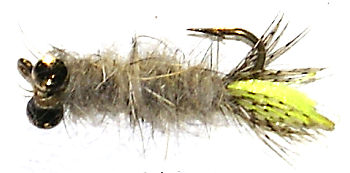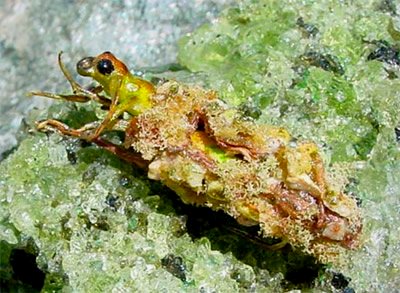Green Peeping Cased Caddis Sedge Nymph
The origins of the green peeping caddis nymph go back to the 1970’s. At that time there were not many fly patterns that tried to imitate the cased caddis stage in the life cycle of a caddis, for use in a river.

GREEN PEEPING CASED CADDIS NYMPH PATTERN Hook size 12 - $US each
Oliver Edwards, a fly tying Yorkshireman, is credited with the original dressing of this fly. After spooning the fish he caught locally he noticed that many of them were during the colder months were feeding on cased caddis. He started to experiment with different fly tying materials until he came up with a design that met with the approval of most trout and grayling, that liked to feed at the bottom on these insects. His creation relied on lead wire wraps around the hook length for weight. He added a distinctive scruffy dressed body to give the impression of the natural’s sticky outer casing that covered in small particles of sand, dirt, and vegetable matter. Partridge fiber was added for legs and Chartreuse wool was used to imitate the emerging pupa. It proved to be a very successful fly.
Oliver Edwards started to get annoyed with the amount of flies he was losing through snagging, on some river beds that were full of debris and weeds. He was aware of the snag reducing abilities of Hans Van Klinken’s (the designer of the Klinkhammer. lesser known nymph fly range of patterns called the “Lead head”. It is not a nymph pattern that is particularly well known. They used a lead-shot outrigger to add a heavy weight at the eye of the hook. This gave the pattern a nose down drifting style. This meant that the hook end of the fly was slightly raised resulting in fewer hook-ups with the bottom

Oliver started to add a split shot, secured by a loop of nylon to the hook eye of his peeping caddis pattern when he was fishing a river or stream that was full of weed beds and rotting vegetation. This trick he had taken from Hans Van Klinken’s fly pattern, made his peeping caddis extra usability.
Oliver’s preferred fishing method with his new fly was to fish up or across stream high-stick style. He tied it on as a point fly under a standard wet fly. With the popularity of the short line nymph fishing technique, following the successful Czech and Polish national fly fishing teams at the world championships in the 1990’s, Oliver had found a new use for his standard peeping caddis fly pattern. It was an ideal heavy fly for the middle or point fly that would help to quickly get the team of flies down deep fast. It also had the benefit of looking like one of the trout and graylings preferred food items so it caught fish.
After a spate, following a rain storm, the peeping caddis fly pattern can be deadly when fished Czech style. Trout and Grayling expect to feed on large food items that have been dislodged by the force of the river. They are actively looking for the natural cased caddis pupa drifting around in the water trying to grab onto something solid on the river bed that can give it shelter and protection from the strong water current. Provide them with an imitation of the type of food they are searching for.
If you are going to a new fishing location carry a pot of superglue and some black green and cream waterproof marker pens in your fishing bag. I know this sounds strange but if you trawl the riverbed with a small net before you fish and find cased caddis that look different to the ones in your fly box coat your fly with some super glue and role it in the same coloured sand, dirt and gravel that covers the river bottom. This is a variation on ‘Matching the Hatch’. Make sure this material is dry before you stick it to your fly. Take it from the river bank or path. You can use the marker pens to alter the colour of the larva on your fly if necessary to match local insects.
CUSTOMER'S COMMENT
I find a long leader on a floating line is the best method to fish your green peeping cased caddis fly. You have to allow time for the fly to sink to the required depth before you start to retrieve. These insects crawl very slowly along the bottom or are occasionally pulled away by a strong current. They never move faster than the speed of the water so it is important to retrieve slowly so as not to spook any nearby grayling or trout. Jason Weller, New Hampshire, USA
CUSTOMER'S COMMENT
The green peeping cased caddis fly is great to trundle along the bottom searching for deep feeding fish in when the water is cold. When it is taken there is plenty of time to tighten as grayling and trout tend to take the natural cased caddis by swallowing it whole. Peter Phillips, New Jersey, USA


Fly Fishing books

